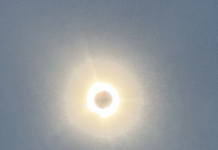I appreciate a good hot breakfast on the weekend. Bring on the egg bake, flavorful sausage, fluffy buttermilk waffles. Pancakes are good as long as they’re not Swedish pancakes (I apologize right now to my Swedish ancestors), and especially good if they’re made with blueberries or chocolate chips. It’s not a secret that I have a sweet tooth, and when you combine hot breakfast foods with pure maple syrup, I’m a happy girl.
But until just recently, I never really thought how the syrup gets into the jug. Well, maybe I thought about it a little bit back in the 80s when I was reading about the maple syrup “sugaring off” contest in Laura Ingalls Wilder’s Little House in the Big Woods, (the first book in the Little House series), but I haven’t given it much thought since then.
 This Saturday, March 31, you can attend maple syruping events in Maplewood State Park from 9 a.m. to 4 p.m. (7 miles east of Pelican Rapids) or Sibley State Park in New London (15 miles north of Willmar). Even though it’s been a less-than-ideal spring for producing maple syrup, with the unseasonably warm temps, you can still learn about the history of maple syruping, see how the maple trees are tapped and the sap is collected and boiled, and try a small sample. Pretend you’re a pioneer for a day! Show up in a horse and buggy, wear a bonnet, and call everyone “Ma” and “Pa.” (Or don’t, it’s totally up to you.)
This Saturday, March 31, you can attend maple syruping events in Maplewood State Park from 9 a.m. to 4 p.m. (7 miles east of Pelican Rapids) or Sibley State Park in New London (15 miles north of Willmar). Even though it’s been a less-than-ideal spring for producing maple syrup, with the unseasonably warm temps, you can still learn about the history of maple syruping, see how the maple trees are tapped and the sap is collected and boiled, and try a small sample. Pretend you’re a pioneer for a day! Show up in a horse and buggy, wear a bonnet, and call everyone “Ma” and “Pa.” (Or don’t, it’s totally up to you.)
If you wonder about things the way I do, you might be wondering, “Who decided it was a good idea to tap the maple trees and then boil the sap down?”
According to the Maple Museum, “An old Iroquois legend describes the accidental discovery of the sugarmaking process. A hunter returned to his dwelling and found an enticing sweetness in the air around the kettle in which his mate was boiling meat. The fluid in the kettle, he learned, was sap and had been collected beneath a broken maple limb.”
Whether this is the truth or a tall tale, I know one thing: Whoever discovered this delicious natural sweetener was a genius. My great uncle Paul even took part in this agricultural tradition, harvesting maple syrup on his property in the tiny, unincorporated town of Connorsville, Wis. One year, my dad and little brother Nick helped out (I was away at college). My dad told me the sap ran fast through thin plastic tubes, like water from a tap, and once it was collected, it was a tedious process boiling the sap to pure maple syrup. It takes about 40 gallons of sap to make one gallon of maple syrup, since 98 percent of sap is water, and if you don’t watch it carefully—making sure the fire doesn’t get too hot or the sap levels get too low— you risk losing a whole batch (burnt syrup doesn’t taste so good). But when it’s boiled just right, the taste is well worth the wait.
Great. It’s the middle of the afternoon and now I’m craving pure maple syrup. Maybe I’ll make these red velvet pancakes when I get home.






